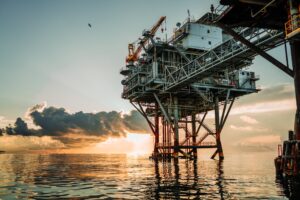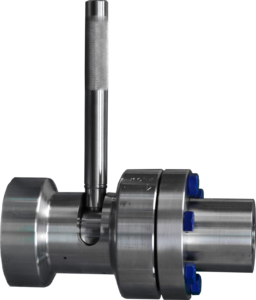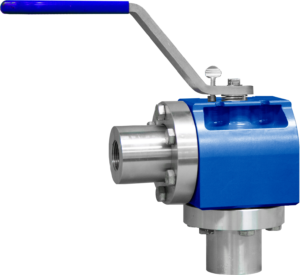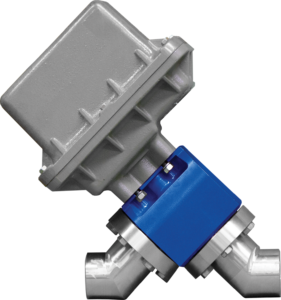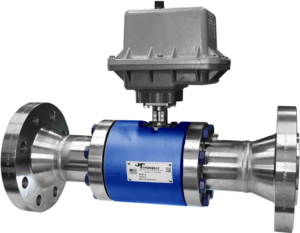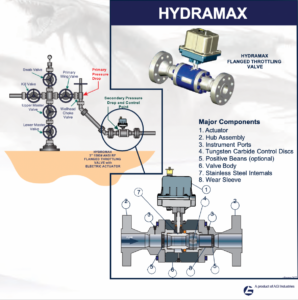Throttle valves (also known as choke valves or control valves) regulate the flow rate or pressure of fluids by increasing or decreasing the cross-sectional area of the flow path. Throttle valves are commonly used in the oil and gas industry to control fluids flowing, such as crude oil, natural gas, and water, through pipelines and other systems.
Hydroplex throttling valves are specifically designed to control either the pressure
or flow of fluids in gathering system applications. The gathering system is the
piping and processing equipment network between the Wellhead to Midstream
pipeline.
The primary purpose is to reduce wellhead pressure, which can be
exceptionally high to transmission line pressure. They are a vital element in
managing either upstream or downstream pressures during various phases of liquid
and/or gas production.
Choke valves are integral and critical components in production systems, and
their proper selection and maintenance are crucial for the safe and efficient
operation of oil and gas facilities. When considering the selection of a throttling valve for production applications it is most critical to thoroughly evaluate the primary operational data used to determine: pressure rating, body configuration, trim size, seal selection, materials of construction, end connections and method of control.
Hydroplex Throttling/Choke Valves
Throttle Valve Pressure Ratings
Throttling applications typically involve high differential pressures than standard valves. They can operate at pressures ranging from 150 psi to several thousand psi, depending on the specific control requirements.
Inline or Angle Valve Design
Throttling valves can have an inline or angle design, and the choice depends on the specific requirements of the application. Trim design and size: Control/Throttling valves use various methods for flow control, including adjustable orifice discs in single staged pressure drops, to a
combination of discs and fixed beans in a multistage pressure drop.
The adjustable trim allows the operators to control the flow or pressure by changing the size of the opening. The proper selection of trim is critical to the control result, and can impact process efficiency, maintenance, and operational profit and loss.
Materials of construction
Throttling valves for high-pressure applications are typically constructed from robust and durable materials that can withstand the higher pressures, high velocity fluid streams, entrained solids and other erosive or corrosive conditions encountered in oil and gas environments, both internal and external. Materials may include stainless steel, alloy steel, or other high-strength materials.
Temperature Considerations
In addition to high pressure, throttling valves may also need to withstand high temperatures associated with oil and gas production. Special materials and seals can be used to enhance temperature resistance.
Connection Types
Choke valve applications use different end connections to ensure a secure and leak-tight fit in the piping system. There are numerous thread and flanged systems available to accommodate the requirements dictated by fluid, pressure, and regulatory requirements.
Compliance with Industry Standards:
Throttle valves for any applications must comply with industry appropriate standards and regulations to ensure safety and reliability. Standards from organizations like the API, ANSI and ASME are relevant.
Applications for Hydroplex Throttle/Choke Valves:
Primary production: (free flow)
The control valve is used until the pressure inside the well drops to levels that make it no longer viable. Pressure is the key to collecting oil from the natural underground rock formations in which it forms. Primary recovery methods are typically only able to extract between 5% and 15% of a well’s potential oil reserves.
Secondary Recovery
Secondary recovery methods can extract an additional 30% of the oil’s reserves by
injecting water or gas and water (WAG) into the well to displace the oil and force it
to the surface. Throttling valves are used to regulate the injection process.
Enhanced Oil Recovery (EOR)
Thermal recovery: This method involves the introduction of heat such as the injection of steam to lower the viscosity, or thin, the heavy viscous oil, and improve its ability to flow through the reservoir. Thermal techniques account for over 40 percent of U.S. EOR production, primarily in California.
Gas Injection
This method uses gases such as natural gas, nitrogen, or carbon dioxide (CO2) that expand in a reservoir to push additional oil to a production wellbore, or other gases that dissolve in the oil to lower its viscosity and improves its flow rate. Gas injection accounts for nearly 60 percent of EOR production in the United States.
Chemical Injection
This method can involve the use of long-chained molecules called polymers to increase the effectiveness of waterfloods, or the use of detergent-like surfactants to help lower the surface tension that often prevents oil droplets from moving through a reservoir.
Chemical techniques account for about one percent of U.S. EOR production. Artificial lift is a method used in the oil and gas industry to increase downhole pressure and push resources up to the surface. Artificial lift processes our throttling valve as either the surface control valve, back pressure or production control valve depending on the method.
Progressive Cavity Pump (PCP)
This method uses a string of rods that rotate all the way to where the pump is located. At that point, a large screw turns and essentially augers fluid out of the well. This is one of the best types of artificial lift for horizontal wells. However, it requires electricity to operate.
Plunger Lift
This method can be used to create a pressure differential and draw liquid up the casing to production equipment. This type of artificial lift is done through the use of a timer control, which is typically connected to a High-Pressure Control Valve.
Gas Lift
This method uses gas to reduce the density of the fluid in the wellbore, allowing the well to produce more oil or gas. Gas lift is often used in wells that have a high gas-to-oil ratio.
Electric Submersible Pump (ESP)
This method uses a pump that is submerged in the wellbore to lift the fluid to the surface. ESP is often used in wells that have a high volume of fluid.
Additional Applications
Control valves are used in a variety of applications in the gathering systems. They are used to direct, and control the flow of oil and gas as they are moved from wellheads through flowlines, and gathering systems. In the gathering system, control valves are used to regulate the flow of oil and gas from the wells to a storage tanks, processing plant, or shipping point.
They are also used as inlet pressure control, slug catcher, back-pressure control, LP/HP separator as belly dump valves and process dump valves, water letdown, vent to flare, flare scrubber, surge control and gas to flare.

